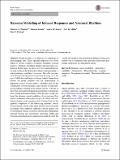| dc.contributor.author | Friston, Karl J. | |
| dc.contributor.author | Pinotsis, Dimitrios | |
| dc.contributor.author | Loonis, Roman Florian | |
| dc.contributor.author | Bastos, Andre M | |
| dc.contributor.author | Miller, Earl K | |
| dc.date.accessioned | 2016-12-02T16:07:41Z | |
| dc.date.available | 2016-12-02T16:07:41Z | |
| dc.date.issued | 2016-10 | |
| dc.date.submitted | 2015-12 | |
| dc.identifier.issn | 0896-0267 | |
| dc.identifier.issn | 1573-6792 | |
| dc.identifier.uri | http://hdl.handle.net/1721.1/105522 | |
| dc.description.abstract | Neural rhythms or oscillations are ubiquitous in neuroimaging data. These spectral responses have been linked to several cognitive processes; including working memory, attention, perceptual binding and neuronal coordination. In this paper, we show how Bayesian methods can be used to finesse the ill-posed problem of reconstructing—and explaining—oscillatory responses. We offer an overview of recent developments in this field, focusing on (i) the use of MEG data and Empirical Bayes to build hierarchical models for group analyses—and the identification of important sources of inter-subject variability and (ii) the construction of novel dynamic causal models of intralaminar recordings to explain layer-specific activity. We hope to show that electrophysiological measurements contain much more spatial information than is often thought: on the one hand, the dynamic causal modelling of non-invasive (low spatial resolution) electrophysiology can afford sub-millimetre (hyper-acute) resolution that is limited only by the (spatial) complexity of the underlying (dynamic causal) forward model. On the other hand, invasive microelectrode recordings (that penetrate different cortical layers) can reveal laminar-specific responses and elucidate hierarchical message passing and information processing within and between cortical regions at a macroscopic scale. In short, the careful and biophysically grounded modelling of sparse data enables one to characterise the neuronal architectures generating oscillations in a remarkable detail. | en_US |
| dc.description.sponsorship | Wellcome Trust (London, England) (Grant 088130/Z/09/Z, NIMH R37MH087027) | en_US |
| dc.description.sponsorship | Picower Institute Innovation Fund | en_US |
| dc.publisher | Springer US | en_US |
| dc.relation.isversionof | http://dx.doi.org/10.1007/s10548-016-0526-y | en_US |
| dc.rights | Creative Commons Attribution | en_US |
| dc.rights.uri | http://creativecommons.org/licenses/by/4.0/ | en_US |
| dc.source | Springer US | en_US |
| dc.title | Bayesian Modelling of Induced Responses and Neuronal Rhythms | en_US |
| dc.type | Article | en_US |
| dc.identifier.citation | Pinotsis, Dimitris A. et al. “Bayesian Modelling of Induced Responses and Neuronal Rhythms.” Brain Topography (2016): n. pag. | en_US |
| dc.contributor.department | Picower Institute for Learning and Memory | en_US |
| dc.contributor.mitauthor | Pinotsis, Dimitrios | |
| dc.contributor.mitauthor | Loonis, Roman Florian | |
| dc.contributor.mitauthor | Bastos, Andre M | |
| dc.contributor.mitauthor | Miller, Earl K | |
| dc.relation.journal | Brain Topography | en_US |
| dc.eprint.version | Final published version | en_US |
| dc.type.uri | http://purl.org/eprint/type/JournalArticle | en_US |
| eprint.status | http://purl.org/eprint/status/PeerReviewed | en_US |
| dc.date.updated | 2016-10-08T04:02:14Z | |
| dc.language.rfc3066 | en | |
| dc.rights.holder | The Author(s) | |
| dspace.orderedauthors | Pinotsis, Dimitris A.; Loonis, Roman; Bastos, Andre M.; Miller, Earl K.; Friston, Karl J. | en_US |
| dspace.embargo.terms | N | en_US |
| dc.identifier.orcid | https://orcid.org/0000-0003-1804-4418 | |
| mit.license | PUBLISHER_CC | en_US |
